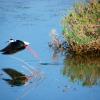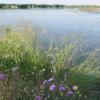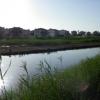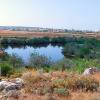Pond environments in Cyprus
Threatened oases
By Stam Zogaris
One of the most extreme semi-arid areas in the European Union is located in the southeastern part of the Island of Cyprus. Because open inland aquatic habitats are so scarce here, any pond-like features are extremely valuable for wildlife. The two wetland areas shown here sustain ponds and pond-like ecosystems and highlight the need to identify and plan for conservation within the concept of « important pond areas for conservation» in the Mediterranean. Both sites are severly threatened by poorly planned housing developments and tourism-fed overdevelopment; hydrological degradation, and uncontrolled human disturbance to wildlife. Both sites are important and exciting wildlife watching hotspots for local and visiting naturalists.
Oroklini Saltmarsh Ponds
Location: immediately next to the sea-side resort area of Oroklini, East of Larnaka.
Shallow intermittent pools within a fairly large brackish wetland located next to the Larnaka/Agia Napa motorway just south of Oroklini village. The « ponds » are remnants of a much larger saltmarsh complex; they are brackish and seasonally saline and are very similar to coastal lagoons in structure yet there is no longer a connection with the sea. Native tamarisk scrub, saltmarshes and rush-beds surround the shallow ponds which are a haven for the Island’s wintering and migratory birds. Several locally rare bird species also breed.
Paralimni Lake Ponds
Location: immediately next to the town of Paralimni, very close to the famous beach resort area of Agia Napa.
Three semi-natural ponds within the degraded basin of a large brackish temporary lake in the semi-arid southeastern part of Cyprus. These ponds were enhanced by artificial dredging in the past to maintain live-stock watering holes. This site is one of the only remaining areas where a documented population of the Cyprus Grass Snake survives.
Action for Ponds: The European Pond Conservation Network
As part of the Pro-pond Project, the European Pond Conservation Network (EPCN, www.europeanponds.org) is working to identify Important Areas for Ponds (IAP). This concept is similar to Plantlife’s Important Areas for Plants and Birdlife International’s Important Areas for Birds. It seeks to identify the most important areas for pond biodiversity. The identification of IAPs has already been carried out in parts of the UK (see: www.pondconservation.org.uk/pond_hap/iap.htm).
This work will help increase awareness of the importance of the pond resource generally, and of IAP pond sites in particular. It will be used to encourage better protection measures for ponds at the regional, national and international scale, and their inclusion in biodiversity and water protection strategies. A preliminary IAP report for the Alpine Arc and the Mediterranean Region was published in summer 2010 on the EPCN website for consultation and review.
What is a pond?
There are many definitions of ponds. The EPCN has chosen a broad definition which includes both man-made and natural ponds: A temporary or permanent standing waterbody between 1m2 and 5 hectares in surface area.
What is an Important Area for Ponds (IAP)?
An IAP is: a geographical area which supports a pond site or network of high biological, social or economic importance. As with the pond definition above, this is also a broad definition which can be applied to a range of geographical scale depending on the characteristics of the ponds of interest. For example an IAP could consist of a single pond cluster, or of a whole region.
How is an IAP identified?
IAPs can either (i) be proposed by pond workers (researchers, site managers etc) or (ii) be identified using GIS techniques and existing plant and animals biological records. To qualify, a pond site need to fulfil one of five criteria based on habitat, species, density or its socio-economic value. Proposed IAPs (pIAPs) will be reviewed through a public consultation process and either accepted as a full IAP, modified or declined. For Cyprus, for example, both Oroklini and Paralimni have been included as selected IAPs for the Alpine Arc and the Mediterranean region. Work is continueing to identify and protect more pond habitats in the Mediterranean.
Links
www.europeanponds.org
http://www.life-medponds.gr









